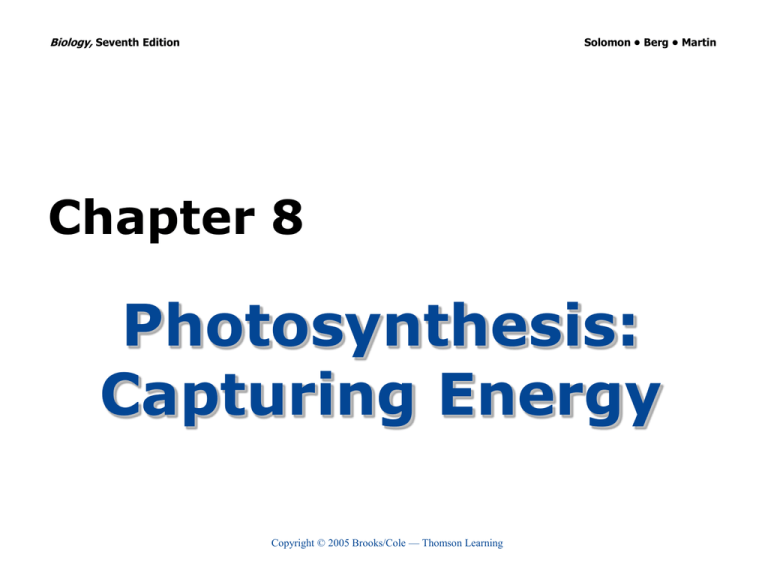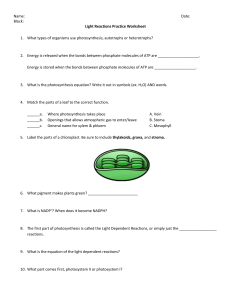The Body in Motion
advertisement

Biology, Seventh Edition Solomon • Berg • Martin Chapter 8 Photosynthesis: Capturing Energy Copyright © 2005 Brooks/Cole — Thomson Learning Biology, Seventh Edition CHAPTER 8 Photosynthesis: Capturing Energy • Light • Composed of photons • Visible light small portion of electromagnetic spectrum • All energy travels as waves • Shorter wavelengths have more energy than longer wavelengths Copyright © 2005 Brooks/Cole — Thomson Learning Biology, Seventh Edition CHAPTER 8 Photosynthesis: Capturing Energy Electromagnetic spectrum Copyright © 2005 Brooks/Cole — Thomson Learning Biology, Seventh Edition CHAPTER 8 Photosynthesis: Capturing Energy • Chloroplasts • Organelles enclosed by a double membrane • Site of photosynthesis • Located mainly within mesophyll cells inside leaf Copyright © 2005 Brooks/Cole — Thomson Learning Biology, Seventh Edition CHAPTER 8 Photosynthesis: Capturing Energy Site of photosynthesis Copyright © 2005 Brooks/Cole — Thomson Learning Biology, Seventh Edition CHAPTER 8 Photosynthesis: Capturing Energy • Chlorophyll • Main photosynthetic pigment • Chlorophyll a, chlorophyll b, carotenoids, and other photosynthetic pigments are components of thylakoid membranes of chloroplasts Copyright © 2005 Brooks/Cole — Thomson Learning Biology, Seventh Edition CHAPTER 8 Photosynthesis: Capturing Energy • Photosynthesis is redox process • Light energy captured and converted to carbohydrates • Hydrogens from water reduce carbon • Oxygen derived from water becomes oxidized Copyright © 2005 Brooks/Cole — Thomson Learning Biology, Seventh Edition CHAPTER 8 Photosynthesis: Capturing Energy • Two phases of photosynthesis • Light-dependent –In thylakoids –Electrons energized by light generate ATP and NADPH • Carbon fixation –In stroma –Compounds generated in phase one provide energy for formation of carbohydrate Copyright © 2005 Brooks/Cole — Thomson Learning Biology, Seventh Edition CHAPTER 8 Photosynthesis: Capturing Energy Overview of photosynthesis Copyright © 2005 Brooks/Cole — Thomson Learning Biology, Seventh Edition CHAPTER 8 Photosynthesis: Capturing Energy • Photosystems I and II • Two types of photosynthetic units involved in photosynthesis • Each photosystem includes –Chlorophyll molecules –Multiple antenna complexes • Photosystem I reaction center –P700 has absorption peak at 700 nm • Photosystem II reaction center –P680 has absorption peak at 680 nm Copyright © 2005 Brooks/Cole — Thomson Learning Biology, Seventh Edition CHAPTER 8 Photosynthesis: Capturing Energy Photosystem Copyright © 2005 Brooks/Cole — Thomson Learning Biology, Seventh Edition CHAPTER 8 Photosynthesis: Capturing Energy • Noncyclic electron transport • ATP and NADPH formed • Electrons energized by absorption of light and pass through electron transport chain to NADP+ • Series of redox reactions • Electrons given up by P680 are replaced by electrons from photolysis of H2O Copyright © 2005 Brooks/Cole — Thomson Learning Biology, Seventh Edition CHAPTER 8 Photosynthesis: Capturing Energy Noncyclic electron transport Copyright © 2005 Brooks/Cole — Thomson Learning Biology, Seventh Edition CHAPTER 8 Photosynthesis: Capturing Energy • Cyclic electron transport • Electrons from photosystem I returned to photosystem I • ATP produced by chemiosmosis • No NADPH or O2 generated Copyright © 2005 Brooks/Cole — Thomson Learning Biology, Seventh Edition CHAPTER 8 Photosynthesis: Capturing Energy Copyright © 2005 Brooks/Cole — Thomson Learning Biology, Seventh Edition CHAPTER 8 Photosynthesis: Capturing Energy • ATP synthesis and electron transport • Electrons move down electron transport chain • Protons (H+) move from stroma to thylakoid lumen, creating proton gradient • Greater concentration of H+ lowers the pH Copyright © 2005 Brooks/Cole — Thomson Learning Biology, Seventh Edition CHAPTER 8 Photosynthesis: Capturing Energy Accumulation of protons in thylakoid lumen Copyright © 2005 Brooks/Cole — Thomson Learning Biology, Seventh Edition CHAPTER 8 Photosynthesis: Capturing Energy Electron transport and chemiosmosis Copyright © 2005 Brooks/Cole — Thomson Learning Biology, Seventh Edition CHAPTER 8 Photosynthesis: Capturing Energy • Carbon fixation • Energy of ATP and NADPH used in formation of organic molecules from CO2 12 NADPH + 18 ATP + 6 CO2 → C6H12O6 + 12 NADP + + 18 ADP + 18 Pi + 6 H2O Copyright © 2005 Brooks/Cole — Thomson Learning Biology, Seventh Edition CHAPTER 8 Photosynthesis: Capturing Energy • Three phases of Calvin cycle • CO2 uptake • Carbon reduction • RuBP regeneration Copyright © 2005 Brooks/Cole — Thomson Learning Biology, Seventh Edition CHAPTER 8 Photosynthesis: Capturing Energy Calvin cycle Copyright © 2005 Brooks/Cole — Thomson Learning Biology, Seventh Edition CHAPTER 8 Photosynthesis: Capturing Energy Summary of photosynthesis Copyright © 2005 Brooks/Cole — Thomson Learning Biology, Seventh Edition CHAPTER 8 Photosynthesis: Capturing Energy C3 and C4 plant structure compared Copyright © 2005 Brooks/Cole — Thomson Learning Biology, Seventh Edition CHAPTER 8 Photosynthesis: Capturing Energy Summary of the C4 pathway Copyright © 2005 Brooks/Cole — Thomson Learning




